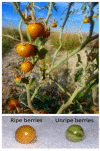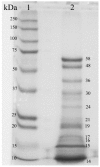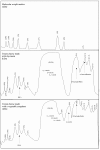Proteolysis and Rheological Properties of Cream Cheese Made with a Plant-Derived Coagulant from Solanum elaeagnifolium
- PMID: 30704018
- PMCID: PMC6406456
- DOI: 10.3390/foods8020044
Proteolysis and Rheological Properties of Cream Cheese Made with a Plant-Derived Coagulant from Solanum elaeagnifolium
Abstract
Cream cheese is a fresh acid-curd cheese with pH values of 4.5⁻4.8. Some manufacturers add a small volume of rennet at the beginning of milk fermentation to improve the texture of the cream cheese. However, there is no information about the effect that proteases other than chymosin-like plant-derived proteases may have on cream cheese manufacture. This work aimed to describe some proteolytic features of the protease extracted from fruits of Solanum elaeagnifolium Cavanilles and to assess the impact that this plant coagulant has on the viscoelastic properties of cream cheeses. Results showed that caseins were not hydrolyzed extensively by this plant-derived coagulant. In consequence, the ratio of milk clotting units (U) to proteolytic activity (U-Tyr) was higher (1184.4 U/U-Tyr) than reported for other plant proteases. The plant coagulant modified neither yield nor composition of cream cheeses, but viscoelastic properties did. Cream cheeses made with chymosin had a loss tangent value (tan δ = 0.257) higher than observed in cheeses made with 0.8 mL of plant-derived coagulant per liter (tan δ = 0.239). It is likely that casein fragments released by the plant-derived coagulant improve the interaction of protein during the formation of acid curds, leading to an increase in the viscoelastic properties of cream cheese.
Keywords: Solanum elaeagnifolium; acid-rennet-curd cheese; cream cheese; plant-derived coagulant; proteolysis; texture.
Conflict of interest statement
The authors declare no conflict of interest.
Figures





Similar articles
-
Milk-Gelling Properties of Proteases Extracted from the Fruits of Solanum Elaeagnifolium Cavanilles.Int J Food Sci. 2022 Oct 18;2022:4625959. doi: 10.1155/2022/4625959. eCollection 2022. Int J Food Sci. 2022. PMID: 36304441 Free PMC article.
-
Exploring the milk-clotting properties of a plant coagulant from the berries of S. elaeagnifolium var. Cavanilles.J Food Sci. 2012 Jan;77(1):C89-94. doi: 10.1111/j.1750-3841.2011.02468.x. Epub 2011 Dec 2. J Food Sci. 2012. PMID: 22133563
-
Factors affecting the retention of rennet in cheese curd.J Agric Food Chem. 2007 Oct 31;55(22):9219-25. doi: 10.1021/jf071105p. Epub 2007 Oct 4. J Agric Food Chem. 2007. PMID: 17914877
-
Cardoon-based rennets for cheese production.Appl Microbiol Biotechnol. 2018 Jun;102(11):4675-4686. doi: 10.1007/s00253-018-9032-3. Epub 2018 Apr 26. Appl Microbiol Biotechnol. 2018. PMID: 29696340 Review.
-
Milk clotting enzymes from marine resources and their role in cheese-making: A mini review.Crit Rev Food Sci Nutr. 2024;64(27):10036-10047. doi: 10.1080/10408398.2023.2220030. Epub 2023 Jun 7. Crit Rev Food Sci Nutr. 2024. PMID: 37287272 Review.
Cited by
-
Isolation and production optimization of a novel milk-clotting enzyme Bacillus velezensis DB219.AMB Express. 2022 Nov 26;12(1):149. doi: 10.1186/s13568-022-01493-9. AMB Express. 2022. PMID: 36435901 Free PMC article.
-
Microbial Dynamics of a Specialty Italian Raw Ewe's Milk Cheese Curdled with Extracts from Spontaneous and Cultivated Onopordum tauricum Willd.Microorganisms. 2023 Jan 15;11(1):219. doi: 10.3390/microorganisms11010219. Microorganisms. 2023. PMID: 36677511 Free PMC article.
-
An Easy and Cheap Kiwi-Based Preparation as Vegetable Milk Coagulant: Preliminary Study at the Laboratory Scale.Foods. 2022 Jul 28;11(15):2255. doi: 10.3390/foods11152255. Foods. 2022. PMID: 35954022 Free PMC article.
-
Fabrication of UF-white cheese: Obtaining a different proteolysis rate, texture, and flavor via using combinations of mesophilic starter culture and Lactobacillus helveticus.Food Sci Nutr. 2023 Oct 16;12(1):328-339. doi: 10.1002/fsn3.3769. eCollection 2024 Jan. Food Sci Nutr. 2023. PMID: 38268878 Free PMC article.
-
Milk-Gelling Properties of Proteases Extracted from the Fruits of Solanum Elaeagnifolium Cavanilles.Int J Food Sci. 2022 Oct 18;2022:4625959. doi: 10.1155/2022/4625959. eCollection 2022. Int J Food Sci. 2022. PMID: 36304441 Free PMC article.
References
-
- Coutouly A., Riaublanc A., Axelos M., Gaucher I. Effect of heat treatment, final pH of acidification, and homogenization pressure on the texture properties of cream cheese. Dairy Sci. Technol. 2013;94:125–144. doi: 10.1007/s13594-013-0148-z. - DOI
-
- Schulz-Collins D., Senge B. Cheese: Chemistry, Physics and Microbiology. Elsevier; New York, NY, USA: 2004. Acid-and acid/rennet-curd cheeses part A: Quark, cream cheese and related varieties; pp. 301–328.
-
- Lucey J.A., Singh H. Formation and physical properties of acid milk gels: A review. Food Res. Int. 1997;30:529–542. doi: 10.1016/S0963-9969(98)00015-5. - DOI
LinkOut - more resources
Full Text Sources

